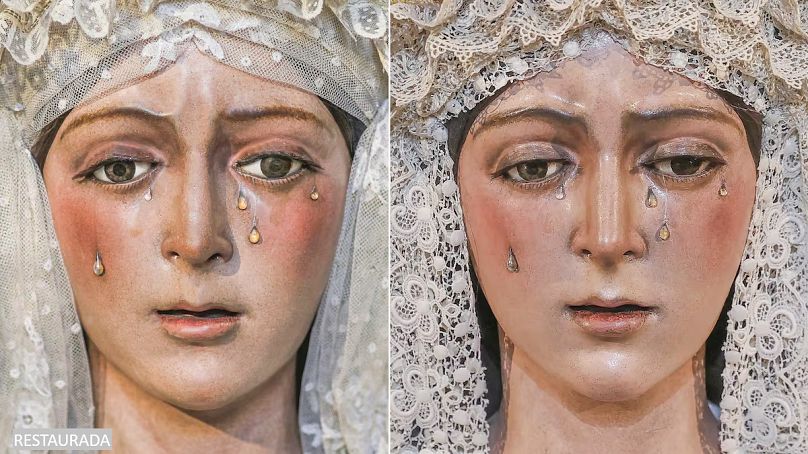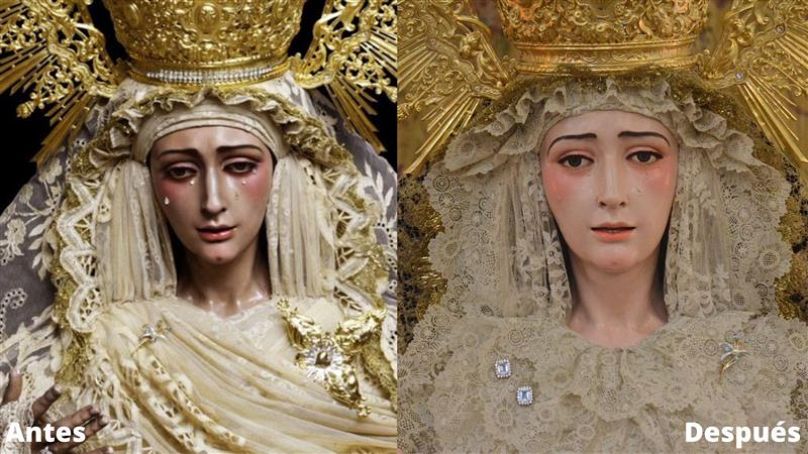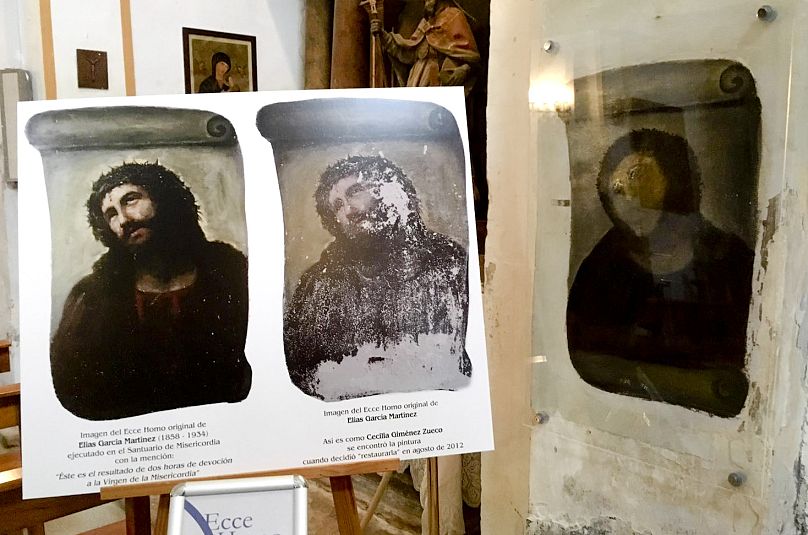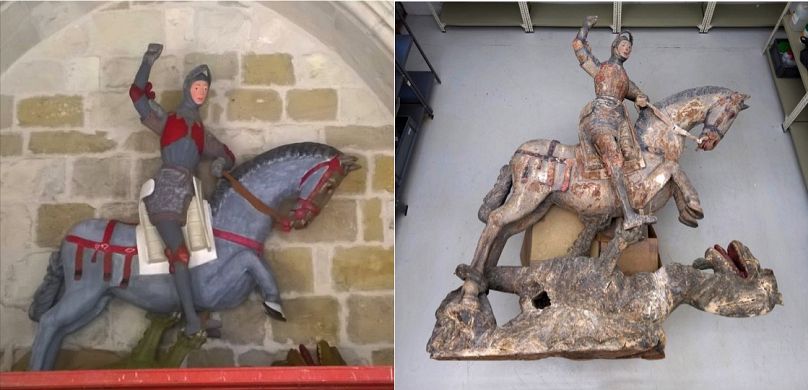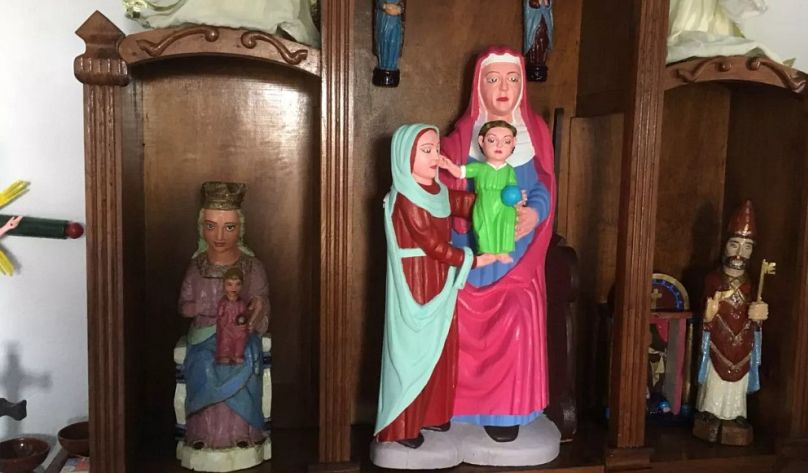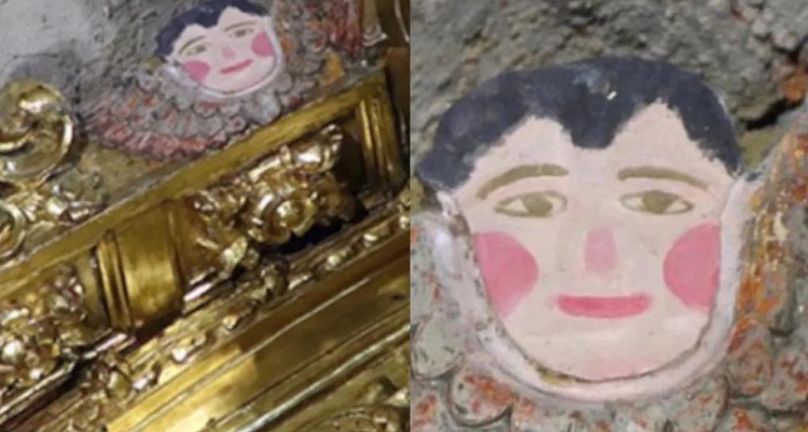Seville is up in arms these days because the newly restored face of the Virgin of La Macarena, a 17th century carving by an unknown artist and of incalculable value to thousands of the faithful which, well, no longer looks the same. After having undergone several retouches between 16 and 20 June, her eyes are somewhat smaller, her gaze is sadder, her eyelashes are longer and even her appearance seems lighter.
The Brotherhood of the Macarena of Seville had commissioned the professor and conservator Francisco Arquillo Torres to touch up the Virgin, although the result, as the reactions of the parishioners have shown, has been closer to acomplete restoration.
Around the church, the cries of hundreds of people gathered to visit the transformed religious image have not ceased, while social networks are still ablaze with the disbelief of users who no longer recognise an icon of Seville.
Among the comments, there is even a theory that the carving has been replaced by a different one, and there are those who compare the modification to cosmetic surgery. “You can’t treat a work of art as if it were a mannequin or a toy,” commented one user.
Two members of the governing board of the Hermandad de la Macarena have resigned as the result of an initiative that could have ended without controversy if a technical committee andthe heritage authorities had been consulted.
As misfortunes never come alone, barely two days after the uproar over the new face of the Macarena virgin, a lawsuit has come to light over the restoration of another virgin in Seville.
Preservation of the work or the immaterial rights of the author?
In this case it is the carving of the Virgin Dulce Nombre de Bellavista, made by the sculptor Luis Álvarez Duarte in 1969 and which was restored at the beginning of 2021 by Darío Ojeda Cordero. Although the HeritageDelegation of the Archdioceseof Seville approved repairswhich were also supervised by experts, as Ojeda Cordero claims, the daughter of the original author has denounced the initiative four years later.
Guadalupe Álvarez Duarte has taken the restorer to court for perceiving features in the Virgin’s physiognomy that are very different from the originals created by her father.
Lawyers for both parties are already working on the process and the dispute is whether the preservationof the material support of the work can take precedence over the immaterial right to the idea of the authorwho conferred it, as the plaintiff’s lawyer has expressed. If awarded damages, the plaintiff has assured that she will donate the money to charity.
The cases mentioned above are more recent, but it is not the first time that a well-intentioned hand has decided to give anartistic work of art a completely different look.
These are the failed restorations that became famous before the retouched face of the Macarena in Seville.
Ecce Homo – ecce scandalo
A work that needs no introduction. This 20th century mural paintingcan be found in the Sanctuary of Misericordia de Borja, in Zaragoza, and is almost as well known nationally and internationally as the Virgin of La Macarena.
It is all thanks to Cecilia Giménez Zueco, an octogenarian amateur painter who saw the work of the painter Elías García Martínez, then a professor at the Zaragoza School of Art, in a somewhat deteriorated state and began restoration work with the consent of the parish priest.
The novelties that Cecilia introduced with her brush were so far removed from the original work that at first they were mistaken for an act of vandalism. National newspapers covered the story and the rest is history. The Internet was filled with memes and humorous videos. A phenomenon emerged that even made it into in a BBC report.
The musical duo Las Bistecs made Cecilia and the ‘Ecce Homo’ one of the main references of their musical genre, baptised as ‘electro-disgusting’, in the song ‘Historia del arte’, whose lyrics read:
“The phallus in trend in all the museums. I have no Euros left to see something so ugly (…) A woman has risen and planted a pine tree, Cecilia is a man, Ecce homo, is divine”. This theme is a critique of art historytold from a male point of view and vindicates Cecilia’ s action as a way of giving new meaning in the present day to a work that would otherwise have been disregarded.
Cecilia even opened an exhibitionof her paintings, this time original and unrestored. The fact is that it made Borja’s Ecce Homo famous and she became a pop phenomenon. She also set a precedent in the field of failed restorations, as all subsequent restorations were labelled as “another Ecce Homo”.
Sculpture of St. George – Navarre
In 2018, the parish priest of the church of San Miguel de Estella, in Navarre, commissioned a local crafts teacher, with no technical knowledge, to restore this statuette of Saint George.
The colours used in an image that already has a naïve appearance gave an even more comical result and, of course, the social networks were the first to express it, again, along with the BBC.
The acrylic facelift of St George aroused the indignation of the Association of Conservators and Restorers of Spain (Acre), until proper conservation worka year later returned the saint to a form closer to what he must have looked like when he was created.
Carvings of Santa Ana – Asturias
Roñadorio, a village of less than twenty inhabitants in Asturias, will probably never again have such an exciting episode as that of appearing on the news, thanks to the creativity of one of its neighbours.
For María Luisa Menéndez, the tobacconist of this small town, three of the carvings in the church were “hideous”, so she decided to colour them in her spare time.
A figure of Saint Anne, accompanied by the Virgin and child, a maternity representing Mary and Jesus and an image of Saint Peter, all dating from the 15th and 16th centuries, were modified with the permission of the parish priest. The Directorate General of Heritage of the Principality of Asturias was not amused.
The altarpiece of the church of San Xoán – Galicia
Two residents of Alto, in Lugo, found an old abandoned altarpiece belonging to the church of San Xoán. Without any knowledge of craftsmanshipor restoration, they decided to investigate and, using old photographs, they carried out the transformation of the piece for a total value of 600€.
In order to decide on the colours they would use to paint the work, they were also inspired by an old altarpiece in a nearby church .
When José Rozas and Manuel Tejeiro presented the result in the church and the new appearance of the altarpiece was made public, the head of the bishopric’s heritage department refused to condone the initiative.
After the Bishopric’s reaction, the neighbours defended their initiative and declared that the Bishopric just did not want thechurch’s years of neglect ofa valuable work of art to come to light.
The cherub of the Parish of San Sebastián – Cantabria
One of the relief figures of the eight angels on the main altarpiece of the parish church of San Sebastián de Reinosa, in Cantabria, no longer exists and there, instead of a figurine or a coffered ceiling, is a two-dimensional smiley face. The imitation cherub, with a triangular nose and a black blob instead of hair, could be the result of a primary school exercise.
In reality, it is a guide placed so as not to leave blank the plaster space that the original would have occupied. At least, this is how the parish priest of the church, Eduardo Guardiola, defended the existence of the caricature because, according to him, “it was no big deal”, as “it could only be seen with binoculars”.
Matrera Castle at Villamartín – Cádiz
Although the restoration project of the Matrera Castle in the Cadiz town of Villamartín was carried out by the architect Carlos Quevedo as an expert supported by the Junta de Andalucía, the result was not without controversy.
The public was not convinced by the new aesthetic of this9th century castle, which was even published in ‘The Guardian’ and ‘The Times’ and was criticised by several cultural heritage organisations .
However, it later received international awards such as the Architizer A+ award in the Preservation category and the American Architecture Prizein the Heritage or Architecture category. It is clear that restoration is never to everyone’s taste.
Figure of the cathedral of Santiago de Compostela – Galicia
This last example is not a failed restoration, but a gratuitous transformation. It occurred to someone in 2018 that a figure on the façade of the cathedral of Santiago de Compostela, dated from the 12th century, could look like a member of the rock band Kiss and made the saint travel to the future by way of a permanent marker.
In addition to being a vandalistic act, it demonstrates once again the seemingly inevitable impulse to think of the legacy of the past under the references and codes of today.



